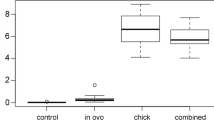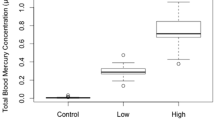Abstract
We conducted a dose–response laboratory study to quantify the level of mercury exposure associated with negative effects on the development of common loon chicks reared in captivity from hatch to 105 days. A dose regimen was implemented that provided exposure levels that bracketed relevant exposure levels of methyl mercury found in loon chicks across North America. We observed no overt signs of mercury toxicosis and detected no significant effect of dietary mercury exposure on growth or food consumption. However, asymptotic mass was lower in chicks that hatched from eggs collected from nests on low pH lakes relative to eggs from neutral pH lakes. Rapid excretion of methyl mercury during feather growth likely provides loon chicks protection from methyl mercury toxicity and may explain the lack of convincing toxicological findings in this study. Lake-source effects suggest that in ovo exposure to methyl mercury or other factors related to lake pH have consequences on chick development.
Similar content being viewed by others
References
Aulerich, R.J., Ringer, R.K. and Iwamoto, S. (1974). Effects of dietary mercury on mink. Arch. Environ. Contam. Toxicol. 2, 34-51.
Association of Official Agricultural Chemists (1990). Mercury in fish. Method 977.15 (modified). In Official Methods of Analysis of the JOAC, 15th edn. VA, USA: Arlington.
Barr, J.F. (1986). Population dynamics of the common loon (Gavia immer) associated with mercury-contaminated waters in northwestern Ontario. Can. Wildl. Serv. Occas. Pap. 56, 25 pp.
Barr, J.F. (1996). Aspects of common loon (Gavia immer) feeding biology on its breeding ground. Hydrobiologia 32, 119-44.
Becker, P.H., Furness, R.W. and Henning, D. (1993). Mercury dynamics in young common tern (Sterna hirundo) chicks from a polluted environment. Ecotoxicology 2, 33-40.
Becker, P.H., Henning, D., Furness, R.W. (1994). Differences in mercury contamination and elimination during feather development in gull and tern broods. Arch. Environ. Contamin. Toxicol. 27, 162-7.
Burnham, K.P. and Anderson, D.R. (1998). Model Selection and Inference: a Practical Information—Theoretic Approach. New York: Springer Verlag.
Evers, D.C., Kaplan, J.D., Meyer, M.W., Reaman, P.S., Braselton, W.E., Major, A., Burgess, N. and Scheuhammer, A.M. (1998). Geographic trend in mercury measured in common loon feathers and blood. Environ. Toxicol. Chem. 17, 173-83.
Fimreite, N. and Karstad, L. (1971). Effects of dietary methylmercury on red-tailed hawks. J. Wildl. Manag. 35, 293-300.
Fournier, F., Karasov, W.H., Kenow, K.P., Meyer, M.W. and Hines, R.K. (2002). The oral bioavailability and toxicokinetics of methylmercury in common loon (Gavia immer) chicks. Comp. Biochem. Physiol. Part A 133: 703-14.
Frederick, P.C., Spalding, M.G., Sepulveda, M.S., Williams, G., Bouton, S., Lynch, H., Arrecis, J., Loerzel, S. and Hoffman, D. (1997). Effects of environmental mercury exposure on reproduction, health and survival of wading birds in the Florida Everglades. Final Report, Florida Department of Environmental Protection. Tallahassee, Florida.
Grissom, R.E. and Thaxton, J.P. (1985). Onset of mercury toxicity in young chickens. Arch. Environ. Contam. Toxicol. 14, 193-6.
Haramis, G.M. and Nice, A.D. (1980). An improved web tagging technique for waterfowl. J. Wildl. Manag. 44, 898-9.
Heinz, G.H. (1974). Effects of low dietary levels of methyl mercury on mallard reproduction. Bull. Environ. Contam. Toxicol. 11, 386-92.
Heinz, G.H. (1979). Methylmercury: reproductive and behavioral effects on three generations of mallard ducks. J. Wildl. Manag. 43, 394-401.
Hoffman, D.J. and Moore, J.M. (1979). Teratogenic effects of external egg applications of methyl mercury in the mallard, Anas platyrhynchos. Teratology 20, 453-62.
Hosmer, D.H. Jr and Lemeshow, S. (1999). Applied Survival Analysis. New York: John Wiley and Sons.
Koehler, A.B. and Murphree, E.S. (1988). A comparison of the Akaike and Schwarz criteria for selecting model order. Appl. Stat. 37, 187-95.
Lindstrom, M.J. and Bates, D.M. (1990). Nonlinear mixed effects models for repeated measures data. Biometrics 46, 673-87.
Matida, Y., Kumada, H., Kumura, S., Saiga, Y., Nose, T., Yokote, M. and Kawatsu, H. (1971). Toxicity of mercury compounds to aquatic organisms and accumulation of the compounds by the organisms. Bull. Freshwater Fish. Res. Lab. (Tokyo) 21, 197-227.
McIntyre, J.W. and Barr, J.F. (1997). Common Loon (Gavia immer). No. 313 in A. Poole and F. Gill, eds. The Birds of North America. The Academy of Natural Sciences, Philadelphia, Pennsylvania.
Meyer, M.W. (1998). Ecological risk of mercury in the environment: the inadequacy of “the best available science”. Environ. Toxicol. Chem. 17, 137-8.
Meyer, M.W., Evers, D.C., Daulton, T. and Braselton, W.E. (1995). Common loons (Gavia immer) nesting on low pH lakes in northern Wisconsin have elevated blood mercury content. Water, Air Soil Pollut. 80, 871-80.
Meyer, M.W., Evers, D.C., Hartigan, J.J. et al. (1998). Patterns of common loon (Gavia immer) mercury exposure, reproduction, and survival in Wisconsin, USA. Environ. Toxicol. Chem. 17, 184-90.
Monteiro, L.R. and Furness, R.W. (2001). Kinetics, dose-response, excretion, and toxicity of methylmercury in free-living Cory's shearwater chicks. Environ. Toxicol. Chem. 20, 1816-23.
Nocera, J.J. and Taylor, P.D. (1998). In situ behavioral response of common loons associated with elevated mercury (Hg) exposure. Conserv. Ecol. (online) 2(2), article 10.
Parkhurst, C.R. and Thaxton, P. (1973). Toxicity of mercury to young chickens 1. Effect on growth and mortality. Poultry Sci. 52, 273-6.
Pichner, J. and Concarlos, M.W. (1986). Hatching and rearing of the common loon (Gavia immer). Amer. Association of Zool. Parks and Aquariums Annu. Proc. 00, 468-72.
Rodgers, D.W. and Beamish, F.W.H. (1982). Dynamics of dietary methylmercury in rainbow trout, Salmo gairdneri. Aquat. Toxicol. 2, 271-90.
Ronald, K., Tessaro, S.V., Uthe, J.F., Freeman, H.C. and Frank, R. (1977). Methylmercury poisoning in the harp seal (Pagophilus groenlandicus). Sci. Tot. Environ. 8, 1-11.
Scheuhammer, A.M. (1991). Effects of acidification on the availability of toxic metals and calcium to wild birds and mammals. Environ. Pollut. 71, 329-75.
Scheuhammer, A.M. and Blancher, P. (1994). Potential risk to common loons (Gavia immer) from methylmercury exposure in acidified lakes. Hydrobiologia 279/280, 445-55.
Spalding, M.G., Frederick, P.C., McGill, H.C., Bouton, S.N. and McDowell, L.R. (2000). Methylmercury accumulation in tissues and its effects on growth and appetite in captive great egrets. J. Wildl. Dis. 36, 411-22.
Thompson, D.R. (1996). Mercury in birds and mammals. In W.N. Beyer, G.H. Heinz and A.W. Redmon-Norwood (eds) Environmental Contaminants in Wildlife: Interpreting Tissue Concentrations, pp. 341-56. Boca Raton, FL, USA: Lewis.
U.S. Environmental Protection Agency (1984). Test Methods for Evaluation of Solid Waste. Methods 3030, 3040, and 7470, Environmental Protection Agency SW-846. 2nd edn. Washington, DC.
U.S. Environmental Protection Agency, (1996). Mercury Study Report to Congress, Vol. 1: Executive Summary. SAB review draft. Environmental Protection Agency 0452/R-96-001a. Washington, DC.
U.S. Environmental Protection Agency, (1997a). Mercury Study Report to Congress, Vol. 5. Environmental Protection Agency 452/R-96-001a. Washington, DC.
U.S. Environmental Protection Agency, (1997b). Mercury study report to Congress, Vol. 6. Environmental Protection Agency 452/R-96-001a. Washington, DC.
Weiner, J.G. (1987). Metal contamination of fish in low-pH lakes and potential implications for piscivorous wildlife. Trans. North Amer. Wildl. Nat. Resources Conf. 52, 645-57.
Wobeser, G. (1975). Prolonged oral administration of methyl mercury chloride to rainbow trout (Salmo gairdneri) fingerlings. J. Fish. Res. Board of Canada 32, 2015-23.
Wobeser, G., Nielsen, N.O. and Schiefer, B. (1976). Mercury and mink II. Experimental methyl mercury intoxication. Can. J. Comp. Med. 40, 34-45.
Wolfe, M.F., Schwarzbach, S. and Sulaiman, R.A. (1998). Effects of mercury on wildlife: a comprehensive review. Environ. Toxicol. Chem. 17, 146-60.
Wolfinger, R. (1993). Covariance structure selection in general mixed models. Communications in Statistics—Simulation 22, 1079-106.
Yonge, K.S. (1981). The breeding cycle and annual production of the Common Loon (Gavia immer) in the boreal forest region. M.Sc. thesis, University of Manitoba, Winnipeg.
Author information
Authors and Affiliations
Corresponding author
Rights and permissions
About this article
Cite this article
Kenow, K.P., Gutreuter, S., Hines, R.K. et al. Effects of Methyl Mercury Exposure on the Growth of Juvenile Common Loons. Ecotoxicology 12, 171–181 (2003). https://doi.org/10.1023/A:1022598525891
Issue Date:
DOI: https://doi.org/10.1023/A:1022598525891




